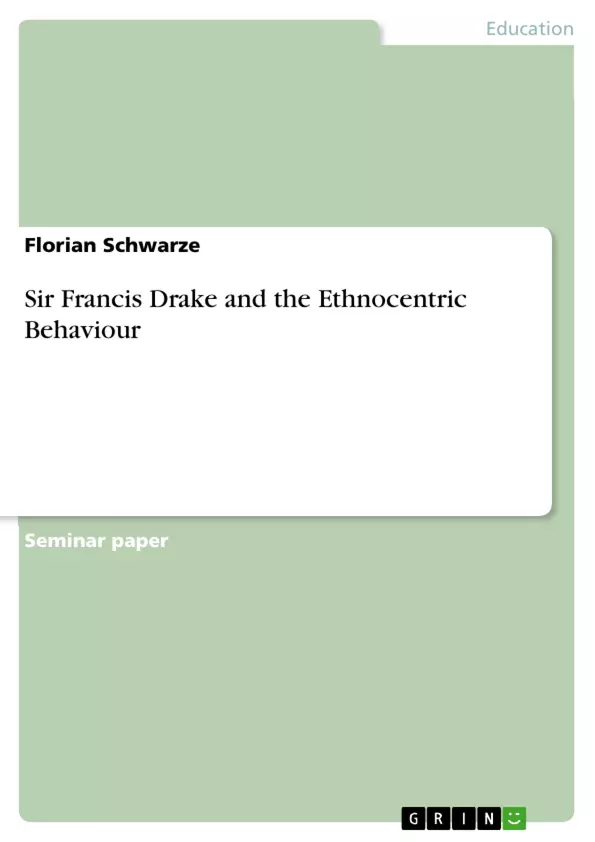England became powerful, when Elizabeth I came to the throne in 1558. During her term England became one of the most powerful empires in the world. The first colonies were founded and the English troops conquered the Spanish Armada. A man called Francis Drake was the first English person, who circumnavigated the world. From “Small” to “Big” that was always the motto he lived and finally became famous with. His motto describes his life, a life which began in modest living conditions and finally reached the highest social classes (Damm 25).
The Spanish feared and admired Francis Drake at the same time. This was due to his great courage and his unpredictability. They called him “El Dragon - The Dragon”. He was hated by many Spaniards, but the King of Spain (Philip I.) hated him the most. He even announced to pay 20.000 ducats, on Drake’s head (Wood 73). This was a great honour for Sir Francis Drake. What was it, that made him so dangerous for the Spanish King, and how did the Queen of England appreciated his doing? In which connection did he stand to Elizabeth I.? Who was this man and what influence did he have in the British Empire and on the British throne?
In this work I will try to find answers to all these questions, but also find out more about his occurrence and behaviour, when he landed on unsettled land. I will try to compare his occurrence and behaviour, to the “Ethnocentric” behaviour. Even though the coinage of the term “Ethnocentrism” itself was first introduced in 1906, “ethnocentric” behaviour can certainly be found centuries before that. When the European settlers began to colonize the “new world”, the land was simply taken from the native population. For the Europeans the Natives were outsiders with no rights. In most cases the explorers showed typical ethnocentric behaviour.
How Sir Francis Drake treated the native population is one of the focuses of this paper. Did he show the same ethnocentric behaviour like most of the others did or was he friendly and nice to the native population?
How did he get in contact with them to communicate?
I will give a closer explanation to the term “Ethnocentrism” and want it stands for, before I analyse the way Drake treated to native people, when he landed in the “New World” (America). Her for I will analyse the narratives by Hakluyt about Sir Francis Drake’s landing in the new world, which was somewhere in the vicinity of what is now San Francisco (The Norton Anthology of English Literature 894 ff).
Table of Contents
- Introduction
- The Life of Sir Francis Drake
- The Early Years of Sir Francis Drake
- Sir Francis Drake as a Pirate and Slave Trader
- The Victory over the Spanish Armada
- Sir Francis Drake and his Connection to Elizabeth I.
- The Circumnavigation of the World
- Ethnocentrism
- What does the Term "Ethnocentrism" stands for?
- Drake's Behaviour in the "New World" - was it "Ethnocentric"?
- Conclusion
Objectives and Key Themes
This paper aims to explore the life and legacy of Sir Francis Drake, a prominent figure in English history during the reign of Elizabeth I. The paper analyzes his rise from humble beginnings to becoming a renowned seafarer, pirate, and eventually, a knight. It delves into his complex relationship with Queen Elizabeth I., his pivotal role in the defeat of the Spanish Armada, and his circumnavigation of the globe. Furthermore, the paper examines the concept of ethnocentrism and analyzes Drake's actions in the New World, exploring whether his behavior can be characterized as ethnocentric.
- Sir Francis Drake's life and accomplishments
- The role of ethnocentrism in the colonization of the New World
- The impact of Drake's actions on the relationship between England and Spain
- Sir Francis Drake's relationship with Queen Elizabeth I.
- The significance of Drake's circumnavigation of the globe
Chapter Summaries
The Introduction provides a brief overview of Sir Francis Drake's life and the historical context of his actions. It introduces the key themes of the paper, including Drake's rise to power, his relationship with the English crown, and his potential ethnocentric behavior.
Chapter 2, "The Life of Sir Francis Drake," delves into Drake's early life, his involvement in the slave trade, his naval exploits against Spain, and his triumph over the Spanish Armada. This chapter explores Drake's complex character, his rise to fame, and his close relationship with Queen Elizabeth I.
Chapter 3, "Ethnocentrism," provides a definition of ethnocentrism and explores the concept's relevance to the historical context of European colonization. It also examines Drake's interactions with native populations in the New World and analyzes whether his behavior can be considered ethnocentric.
Keywords
This paper primarily focuses on the life and actions of Sir Francis Drake, exploring his rise to prominence, his relationship with Queen Elizabeth I, his role in the defeat of the Spanish Armada, and his circumnavigation of the globe. It delves into the concept of ethnocentrism and analyzes Drake's behavior in the New World to determine whether his actions can be considered ethnocentric. The paper also discusses the historical context of European colonization, the slave trade, and the complex relationship between England and Spain during this period. Key terms include ethnocentrism, colonialism, slave trade, English monarchy, Spanish Armada, circumnavigation, and the New World.
- Citation du texte
- Florian Schwarze (Auteur), 2010, Sir Francis Drake and the Ethnocentric Behaviour, Munich, GRIN Verlag, https://www.grin.com/document/161781



